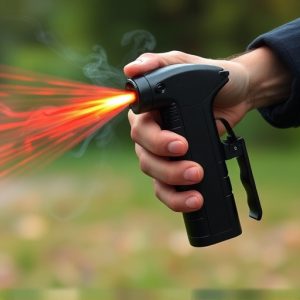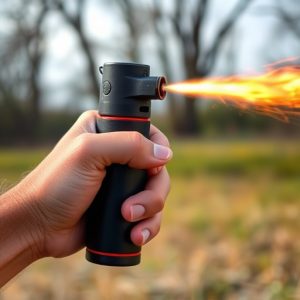Mastering Pepper Spray: Best Techniques for Personal Protection
Chemical irritants like capsaicin-based pepper spray are powerful personal defense tools that tempor…….
Chemical irritants like capsaicin-based pepper spray are powerful personal defense tools that temporarily disable attackers by irritating their eyes and respiratory systems. The best pepper spray self-defense techniques involve aiming for the face, disabling the opponent long enough to escape or seek help. Selecting the right pepper spray requires understanding intended use, range, and potency; effective methods also include proper training in application, wind conditions awareness, target practice, and regular maintenance. Regular low-light or stressful condition training builds muscle memory, while knowledge of local laws ensures a reliable self-defense tool.
“Uncover the power of chemical irritants as game-changers in personal protection. In today’s world, understanding the science behind pepper spray and its role in self-defense is crucial for folks seeking safety. This comprehensive guide explores the effectiveness of pepper spray, offering insights into its mechanism of action and why it’s a popular choice. We’ll navigate choosing the best pepper spray, from potency to features, ensuring you’re prepared. Additionally, discover mastering best pepper spray self-defense techniques, providing strategies for real-world applications.”
- Understanding Chemical Irritants and Their Role in Self-Defense
- The Science Behind Pepper Spray: How It Works and Its Effectiveness
- Choosing the Best Pepper Spray for Personal Protection
- Mastering Pepper Spray Self-Defense Techniques: Tips and Strategies
Understanding Chemical Irritants and Their Role in Self-Defense
Chemical irritants play a pivotal role in self-defense strategies, particularly when it comes to pepper spray, one of the most common and effective personal protection devices. These substances are designed to cause temporary discomfort or disability in an attacker, providing the user with precious time to escape or seek help. Understanding how chemical irritants work is crucial for anyone looking to employ the best pepper spray self-defense techniques.
When used appropriately, pepper spray can disable an assailant by irritating their eyes and respiratory system. The active ingredient, typically capsaicin, triggers a burning sensation and makes it challenging for the target to breathe or see clearly. This temporary blindness and breathing difficulty allow the user to retreat safely while also potentially deterring further aggression. By knowing the mechanics of chemical irritants, individuals can better arm themselves with knowledge, ensuring they’re prepared to defend themselves effectively in various scenarios.
The Science Behind Pepper Spray: How It Works and Its Effectiveness
Pepper spray, a popular self-defense tool, is designed to incapacitate an attacker temporarily and allow the user to escape or seek help. The active ingredient in pepper spray is capsaicin, the same chemical that gives chili peppers their heat. When sprayed into the eyes and face, capsaicin binds to pain receptors, causing intense irritation and a burning sensation. This overstimulation leads to temporary blindness, teary eyes, coughing, and difficulty breathing, giving the user valuable time to get away safely.
The effectiveness of pepper spray lies in its ability to disrupt an attacker’s balance and coordination. With proper application, it can disable an opponent long enough for a victim to escape or call for help. Best Pepper Spray Self Defense Techniques often involve aiming for the face, as this is where the most sensitive nerves are located, ensuring maximum impact with minimal use. Regular training and familiarity with the device’s mechanism are crucial to ensure its successful deployment in high-stress situations.
Choosing the Best Pepper Spray for Personal Protection
When selecting a pepper spray for personal protection, understanding your needs and the features of different options is key. The best pepper spray isn’t one-size-fits-all; it depends on factors like intended use, range required, and the level of protection needed. For instance, if you’re looking to deter attackers at close range, a stronger concentration with a shorter effective range might be ideal. Alternatively, for self-defense in larger spaces or outdoor areas, consider a spray with longer reach and slightly lower potency.
Effective self-defense techniques involve not just the right pepper spray but also knowing how to use it. Training in application methods, understanding wind conditions, and practicing target areas are crucial skills to master. Remember, the best defense is one that gives you confidence and ensures your safety.
Mastering Pepper Spray Self-Defense Techniques: Tips and Strategies
Pepper spray, a powerful chemical irritant, is a popular self-defense tool known for its effectiveness in neutralizing attackers temporarily. Mastering the best pepper spray self-defense techniques can significantly enhance your personal safety. Start by understanding the spray’s mechanics; aim for the eyes, nose, and mouth—these areas are most sensitive to capsaicin, the active ingredient. Practice various application methods, including the wind-back and finger-point techniques, to ensure you can deploy the spray accurately under stress.
Beyond technique, familiarize yourself with different pepper spray devices. Spray guns, for instance, offer a range advantage, while single-use cans are compact and readily available. Train regularly to build muscle memory, especially in low-light or stressful scenarios. Additionally, keep your spray well-maintained and familiarize yourself with local laws regarding its use, ensuring you have a reliable self-defense tool at the ready.
In conclusion, chemical irritants like pepper spray play a pivotal role in personal protection devices. Understanding their science and effectiveness is crucial for choosing the best pepper spray suitable for your needs. Mastering the best pepper spray self-defense techniques ensures you’re prepared to handle potentially dangerous situations with confidence and safety. Equip yourself with knowledge and the right tools, and always stay vigilant—your well-being is paramount.


